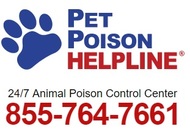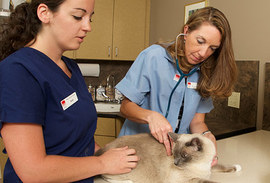|
Brutus, Duke, Coco, Lola and Jake...sure, they're fairly common pet names, but they're also the names of just a few of the pets that died last year because they were left in cars on warm (and not necessarily hot) days while their owners were shopping, visiting friends or family, or running errands. What's so tragic is that these beloved pets were simply the victims of bad judgment. Want numbers? An independent study showed that the interior temperature of vehicles parked in outside temperatures ranging from 72 to 96° F rose steadily as time increased. And cracking the windows doesn't help. ...add to that the fact that most pets are not properly restrained while in the car, and you've got some dangerous situations – for people and pets alike. Unrestrained pets can be seriously or fatally injured, or could even hurt you, in a collision or sudden braking situation. In addition, they're a distraction for the driver, which increases the risk of driver errors. According to a 2010 American Automobile Association (AAA) survey, 2 out of 3 owners engage in distracting behaviors (playing with, feeding or petting their dog, or letting their dog sit in their lap) when pets are in the car...and according to the National Highway Traffic Safety Administration (NHTSA), approximately 20% of injury crashes involve distracted driving. Please don't become another statistic: only take your pets in the vehicle with you when you absolutely need to, and always properly restrain your pets while in the vehicle. How can you help prevent these injuries and deaths?
A Peaceful Farewell provides compassionate at home pet euthanasia to fellow pet owners in Chandler, Gilbert, Mesa, Tempe, Ahwatukee, Scottsdale, and most of the Greater Phoenix Metropolitan Area.
0 Comments
 Can cats get along with dogs? The answer is simply yes, says Dr. Liz Bales, a Philadelphia veterinarian. As long as pet parents take their time and follow a few simple rules for introducing cats to dogs, there’s no reason why felines and canines can’t develop a harmonious relationship. Keep Them Separated If you are bringing a new dog or cat into your home, it’s important that the pet gets adjusted to a new space without the added stress of additional animals right away. In this instance, Bales suggests keeping the cat in a separate environment with plenty of stimulation for several days. A closed bedroom or large bathroom decked out with scratching posts, toys, food, water and the litter box is the perfect option for a new cat. Be sure to also give him a lot of attention during this time. If you’re bringing home a new dog, consider keeping your existing cat in a separate portion of the house and follow crate-training protocol with the dog. Bales suggests placing some of each animal’s personal items—like beds—in the other animal’s space during this time period so that the cat and the dog become accustomed to each other’s scents. You can repeat this process until it’s no longer stressful for both animals. Once your cat is calm, eating well, and using the litter box consistently, it’s time to make the introductions. Keep the First Meeting Quick When you are ready to introduce your cat to your dog, make the initial meeting a quick one—approximately ten minutes. Keep the dog on a leash and allow the cat to roam around and venture as close to the dog as he or she wishes. Use a head collar (halter) on your dog if there is a chance that you may not be in complete control of the situation. Reward your dog with treats and praise for calm behavior around the cat. As long as the process is going smoothly, gradually increase the time the animals spend together. Once you feel comfortable, allow your dog to also move around freely, but keep his or her leash attached so that you can quickly regain control if needed. Be patient—it may take weeks or even months for cats and dogs to finally accept each other and be comfortable. Consider Your Pet’s Personality Dr. Lisa Radosta, a board certified veterinary behaviorist in West Palm Beach, Florida, says that your cat or dog’s personality is a good predictor of his or her ability to get along with another pet. “If your cat has lived with dogs previously and is confident around other animals, you are likely to have an easy transition,” she said. “However, if your cat puffs up, hisses, or runs from other animals, you will have a more difficult time.” Dr. Radosta also says to consider your dog’s personality. “Is he playful but not aggressive? Dogs with this temperament will more easily adapt to a cat. The dog who is lunging, growling, and difficult to control may never be safe with your cat. If this is the case, consult your veterinarian.” If your cat is the confident type and your dog is the easygoing type, it is best to let your cat handle things. Even then, however, the meeting should not be free-for-all. “Put your cat on a higher surface than the dog and put your dog on the leash for the meeting,” Dr. Radosta said. Supervision is Key Keep your cat and dog separated when you cannot directly supervise them until you are fully confident that they present no risk, Dr. Radosta said. The safest way to do this is to keep your dog in a crate. “Even a dog who simply wants to play can seriously or fatally injure a cat,” she said. “Dogs can jump over or bust through baby gates leaving cats in a dangerous situation.” Likewise, you’ll want to provide your cat with a safe place where he or she can escape the dog. This could be a cat tree that the dog cannot climb or a separate room with a cat door installed. “Once cats run, dogs chase. It is very important to prevent this at all costs,” Dr. Radosta said. Brush Up on Your Dog’s Skills In order to help your cat feel safe, your dog has to be under control. He will need to know basic commands such as “leave it,” “sit,” and “stay.” Before the first introduction, make sure to spend time practicing commands with your dog and keep treats handy so that you can reward your dog for good behavior. “When your dog sees the cat, ask him to sit and reward him,” Dr. Radosta said. If the only thing your dog has to do is chase your cat, chasing your cat is going to be his favorite activity. “Keep your dog very well exercised and busy by using food toys and rotating his toys so that he is constantly occupied,” she said. “You can even reserve these fun activities for times when your cat is loose in the house.” Long walks and daily exercise can also help your dog burn off energy—making meetings with the family cat less crazy. You never know which pet is going to be the leader of the pack, but taking the steps to properly introduce a cat to a dog—and practicing patience—will help things run smoothly in your blended-pet household. Source: PetMD / Stacia Friedman A Peaceful Farewell provides compassionate at home pet euthanasia to fellow pet owners in Chandler, Gilbert, Mesa, Tempe, Ahwatukee, Scottsdale, and most of the Greater Phoenix Metropolitan Area.
 Avoid the Holiday EmergencyThe holiday season may be a time for giving, except when it comes to giving certain table scraps to your dog. Foods commonly found on our dinner and party tables such as turkey, pork and cheese are too high in salt and fat for our pets. An overload of fat can even lead to medical issues like pancreatitis, which causes the pancreas to become inflamed. Forgo the holiday table scraps for Fluffy and Fido this year, especially when it comes to these 5 foods, which can be deadly if consumed in sufficient quantity. 1. Chocolate Chocolate is a well known off-limits indulgence for dogs. However, during the holidays many people use baking chocolate in recipes and forget about the ingredient by the time the desert hits the table. According to Dr. Tina Wismer, medical director at the ASPCA Animal Poison Control Center, the darker the chocolate is, the more serious the poisoning can be — making baker’s chocolate and cocoa powder more dangerous than milk chocolate. Make sure this holiday season that your dog does not ingest any chocolate, especially dark chocolate or baker's chocolate. 2. Onions (and Garlic) Onions, garlic and other foods in the Allium family, such as leeks and scallions, can all be extremely poisonous to dogs if consumed in sufficient quantity. "Onion and garlic poisoning results in oxidative damage to the red blood cells (making the red blood cells more likely to rupture) and gastroenteritis (e.g., nausea, oral irritation, drooling, abdominal pain, vomiting, diarrhea)," according to the Pet Poison Helpline. Garlic is also considered to be about five times as potent as onions, so think again before offering your dog some potatoes with the ingredient. 3. Raisins (and Grapes) Most stuffing recipes include raisins as an ingredient, which can be toxic to your dog. Raisins and grapes (which is the un-dried version of a raisin) can cause vomiting, diarrhea and eventually acute renal failure in dogs. 4. Xylitol While you may be making the healthier choice by cooking with artificial sweeteners over the real thing, sweeteners containing Xylitol are poisonous to dogs, causing vomiting, tremors, seizures, tarry stool and even death. According to the Pet Poison Helpline (PPH), a 10-pound dog would only need to eat a single piece of sugar-free gum to reach a potentially toxic dose. 5. Alcohol Beer, wine and cocktails aside, alcohol can also be found in desserts and can be created in your dog’s stomach if they ingest homemade or store bought yeast dough used in making holiday breads and rolls. Even small amount of alcohol, both ingested through alcoholic beverages and produced in the stomach, can be life threatening, making it important to call your vet before you notice any serious poisoning symptoms like seizures. Source: Pet MD A Peaceful Farewell provides compassionate at home pet euthanasia to fellow pet owners in Chandler, Gilbert, Mesa, Tempe, Ahwatukee, Scottsdale, and most of the Greater Phoenix Metropolitan Area.
 1. It is a myth that dogs are color blind. They can actually see in color, just not as vividly as humans. It is akin to our vision at dusk. 2. Dogs DO have better low-light vision than humans because of a special light-reflecting layer behind their retinas 3. A German Shepherd guide dog led her blind companion the entire 2100 mile Appalachian Trail 4. If never spayed or neutered, a female dog, her mate, and their puppies could produce over 66,000 dogs in 6 years! 5. Dogs’ only sweat glands are between their paw pads 6. Like human babies, Chihuahuas are born with a soft spot in their skull which closes with age 7. The breed Lundehune has 6 toes and can close its ears 8. Teddy Roosevelt’s dog, Pete, ripped a French ambassador’s pants off at the White House 9. President Lyndon Johnson had two beagles named Him and Her 10. Franklin Roosevelt spent $15,000 for a destroyer to pick up his Scottie in the Aleutian Islands 11. In Roman times, mastiffs donned light armor and were sent after mounted knights 12. The Russians trained dogs during WWII to run suicide missions with mines strapped to their backs 13. A dog’s mouth exerts 150-200 pounds of pressure per square inch 14. … with some dogs exerting up to 450 pounds per square inch. 15. A one year old dog is as mature, physically, as a 15 year old human 16. The U.S. has the highest dog population in the world 17. France has the 2nd highest 18. The average city dog lives 3 years longer than a country dog 19. 87% of dog owners say their dog curls up beside them or at their feet while they watch T.V. 20. Dogs can be trained to detect epileptic seizures 21. 15 people die in the U.S. every year from dog bites 22. In 2002 alone, more people in the U.S. were killed by dogs than by sharks in the past 100 years 23. Gidget is the name of the Taco Bell dog 24. Newfoundlands are great swimmers because of their webbed feet 25. Basset Hounds cannot swim 26. Greyhounds are the fastest dogs on earth, with speeds of up to 45 miles per hour 27. Bingo is the name of the dog on the side of the Cracker Jack box 28. The bible mentions dogs 14 times 29. Three dogs survived the sinking of the Titanic – a Newfoundland, a Pomeranian, and a Pekingese 30. The Labrador Retriever is the #1 favorite breed in the U.S., Canada, and the U.K. 31. Obesity is the #1 health problem among dogs 32. An estimated 1,000,000 dogs in the U.S. have been named as the primary beneficiaries in their owner’s will 33. An American Animal Hospital Assoc. poll found that 33% of dog owners admit to talking to their dogs on the phone and leaving answering machine messages for them while away 34. Dog’s nose prints are as unique as a human’s finger prints and can be used to accurately identify them 35. At the end of the Beatles’ song “A Day in the Life”, a high-pitched dog whistle was recorded by Paul McCartney for his sheepdog 36. 70% of people sign their pet’s name on greeting and holiday cards 37. 58% put pets in family and holiday portraits 38. There are only 350 Cisky Terriers in the world – perhaps the rarest breed 39. The phrase “raining cats and dogs” originated in 17th century England when it is believed that many cats and dogs drowned during heavy periods of rain. 40. Dogs have no sense of “time” 41. Humans have kept dogs as pets for over 12,000 years 42. The largest breed of dog is the Irish Wolfhound 43. The world’s smallest dog breed is the Chihuahua 44. The St. Bernard is the heaviest 45. Only dogs and humans have prostates 46. But dogs do not have an appendix 47. Every dog on earth likely descended from a species knows as the Tomarctus – a creature that roamed the earth over 15 million years ago 48. The oldest known breed is likely the Saluki – originally trained by Egyptians to help them track game. 49. In 1957, Laika became the first living being in space via an earth satellite 50. … while JFK’s terrier, Charlie, father 4 puppies with Laika’s daughter 51. An African wolf dog known as the basenji is the only dog in the world that cannot bark 52. There are 703 breeds of purebred dogs 53. Dachshunds were originally bred for fighting badgers 54. The world’s smartest dogs are thought to be (1) the border collie, (2) the poodle, and (3) the golden retriever 55. … while the dumbest dog is believed to be the Afghan hound 56. A dog’s smell is more than 100,000 times stronger than that of a human’s 57. … which they need because their eyesight is not as keen as a human’s. 58. Dogs judge objects first by their movement, then by their brightness, and lastly by their shape 59. Chocolate contains a substance known as theobromine (similar to caffeine) which can kill dogs or at the very least make them violently ill 60. George Washington had thirty six dogs – all foxhounds – with one named Sweetlips 61. All dogs are identical in anatomy – 321 bones and 42 permanent teeth 62. Smaller breeds mature faster than larger breeds 63. Female dogs are only ready to mate – “in heat” – twice a year for a total of roughly 20 days 64. Puppies sleep ninety percent of the day for their first few weeks 65. Rin Tin Tin was the first Hollywood dog star 66. … and he really signed his movie contracts – all 22 of them – with a pawprint 67. The Wizard of Oz’s Toto was played by a female Cairn Terrier named Terry 68. Their vision is not fully developed until after the 1st month 69. Dogs have two times as many muscles to move their ears as people 70. The longer a dog’s nose, the more effective it’s internal cooling system 71. An elderly woman was saved by her 12 pound Yorkshire Terrier who fought off an 80 pound Akita and survived with only 9 stitches 72. U.S. Customs dogs “Rocky” and “Barco” were so good at patrolling the border that Mexican drug lords put a $300,000 bounty on their heads 73. Dogs are all direct descendants of wolves 74. Wolves and dogs can mate to produce fertile offspring 75. Female wolves have been known to travel great distances to regurgitate full meals for their hungry pups 76. Cerberus was the tri-headed dog that guarded the underworld in Greek mythology 77. Female dogs bear their young for 60 days before they’re born 78. Dogs’ sense of hearing is more than ten times more acute than a human’s 79. Humans can detect sounds at 20,000 times per second, while dogs can sense frequencies of 30,000 times per second. 80. The earliest dog fossil dates back to nearly 10,000 B.C. 81. Bloodhounds are prized their ability to single out and identify a number of scents simultaneously 82. Dalmatian puppies are born completely white. 83. The Ancient Chinese carried Pekingese puppies in the sleeves of their robes 84. Boxers are so named because of their manner of playing with their front paws 85. All breeds of dog have been found to attack livestock – from 3 month old puppies, all the way up to thirteen year old poodles 86. A dog’s heart beats up to 120 times per minute, or 50% faster than the average human heartbeat of 80 times per minute 87. The oldest dog on record – a Queensland “Heeler” named Bluey – was 29 years, 5 months old 88. Davy Crockett had a dog named Sport 89. Dogs were first domesticated by cavemen 90. Dogs live 15 years on average 91. Many foot disorders inn dogs are simply an issue of long toenails 92. More than 5,000,000 puppies are born in the U.S. every year 93. More than 1 in 3 American families own a dog 94. Average body temperature for a dog is 101.2 degrees 95. The Girl Scouts and Boy Scouts both offer merit badges in dog care 96. Dogs are natural pack animals 97. They are naturally submissive to any creature with higher pack status – human or canine 98. After birth, puppies’ eyes do not fully open until they’re about 12 days old 99. Dogs with little human contact in the first three months typically don’t make good pets 100. The Chihuahua was named after the state in Mexico where they were discovered Source: cesar.com A Peaceful Farewell provides compassionate at home pet euthanasia to fellow pet owners in Chandler, Gilbert, Mesa, Tempe, Ahwatukee, Scottsdale, and most of the Greater Phoenix Metropolitan Area.
 Fun Facts About Dogs
A Peaceful Farewell provides compassionate at home pet euthanasia to fellow pet owners in Chandler, Gilbert, Mesa, Tempe, Ahwatukee, Scottsdale, and most of the Greater Phoenix Metropolitan Area.
Although it’s nearly impossible to predict which breed of dog will live the longest or be the healthiest, there are certain breeds that seem to have lower instances of genetic diseases, bone-related injuries and conditions relating to their skin and coat. Take a look at which breeds are thought to be among the healthiest and how to help your dog live a long, healthy life, below. Australian Cattle Dog While there’s no way to prove which breed is the healthiest, some working breeds, including Australian Cattle Dogs, may be among those with the least number of health-related issues. “Unfortunately, there’s no hard data that provides a scientific answer,” said Jennifer Coates, DVM in Fort Collins, Colorado and veterinary advisor to petMD.com. “In my experience, dogs that are still being bred to do a job tend to be the healthiest.” Australian Cattle Dogs have been traditionally used for cattle herding and have remained popular working dogs because of their intelligence, problem solving skills and soft but assertive bites with cattle. With a lifespan of about 10 to 13 years, Australian Cattle Dogs make excellent companions to high-energy families or on-the-go owners. Major health concerns include hip dysplasia, elbow dysplasia and deafness. Foxhound Another working breed listed as one of the healthiest by Coates, Foxhounds have been primarily used for foxhunting and, because of their working dog genes, may be healthier than dogs bred for show. “When breeders focus on function instead of just good looks, they naturally weed out the dogs that develop debilitating illnesses or injuries,” Coates explained. With a lifespan of 11 to 13 years, Foxhounds make an excellent choice for families who live in rural areas or on large farms and are not prone to many major health problems. They require moderate daily exercise in the form of a walk or jog and need minimal grooming aside from an occasional brushing. German Shorthaired Pointer An all-purpose hunting dog known for its intelligence and proficiency with many different types of game and sport, the German Shorthaired Pointer is another healthy breed, according to Coates. With an average lifespan of 12 to 14 years, German Shorthaired Pointers are prone to health concerns like hypothyroidism, hip dysplasia and gastric torsion. A high-energy breed that requires plenty of daily exercise, German Shorthaired Pointers will need plenty of access to the outdoors and, like all breeds, require mental stimulation throughout the day. “Providing dogs with mental stimulation, physical exercise and maintaining them at a healthy weight will go a long ways towards keeping any dog healthy, regardless of its breed,” Coates shared. Border Collie Another high-energy breed renowned for its agility, intelligence and obedience, Coates lists the Border Collie as one of healthiest. With a lifespan of 10 to 14 years, Border Collies are prone to health problems including seizures and hypothyroidism. A breed that is eager to please with a high level of trainability, Border Collies should be provided with plenty of daily exercise as well as regular access to the outdoors. Chihuahua Known for being the smallest breed in the world, Chihuahua’s are loyal, intelligent, and among the healthiest breeds, according to Denise Petryk, DVM and director of veterinary services at Trupanion pet insurance. With an average lifespan of 14 to 18 years, Chihuahua’s are known to suffer from health conditions including hypoglycemia, patellar luxation and pulmonic stenosis, a heart valve disorder. A smooth-coated Chihuahua requires minimal grooming while longhaired varieties require brushing two to three times a week. Because of their size, Chihuahuas require minimal exercise beyond a short walk. Havanese Compared to other dogs of the same size, Petryk also lists the Havanese among healthy breeds. A popular friendly pet known for its friendly demeanor, Havanese live between 12 to 14 years and suffer from health problems including patellar luxation, deafness and elbow dysplasia. A non-shedding breed that requires brushing several times per week to prevent tangles, the Havanese breed requires short walks to meet their exercise needs. In addition to keeping your pup fit, Petryk also recommends offering your dog high quality food and treats to help them stay healthy. Australian Shepherd With relatively few claims for bone-related injuries as well as conditions related to the coat and skin, Australian Shepherds are also relatively healthy, according to Petryk. An all-purpose farm dog, Australian Shepherds are intelligent, obedient and agile and require regular exercise and mental stimulation. With an average lifespan of 12 to 15 years, the breed is prone to health issues including hip dysplasia, hypothyroidism and Collie Eye Anomaly, an inherited congenital eye condition. Australian Shepherds require minimal grooming beyond an occasional combing and, as with all dog breeds, Petryk recommends giving your dog regular, high quality flea and tick prevention with products recommended by your veterinarian to maintain its health. LabradoodleA popular mixed breed that is a cross between a Labrador Retriever and a Poodle, Petryk lists Labradoodles among those with relatively few claims for bone-related injuries and conditions related to the coat and skin. The breed’s coat should be shampooed and brushed regularly and trimmed at least twice a year. They may suffer from health conditions commonly seen in its parent breeds including hip dysplasia, Addison’s disease and eye disorders including progressive retinal atrophy. To ensure your dog lives a long, healthy life, Petryk recommends establishing a relationship with a veterinarian you like and keeping up-to-date with any preventative vaccinations they suggest. She also advises pet owners to schedule annual physical examinations for their dogs, including dental assessments. Siberian Husky A medium-sized dog renowned for its abilities as a sled and racing dog, the Siberian Husky is relatively healthy compared to other breeds of the same size, Petryk said. While the breed is still used as a working dog, it has also become a loving pet for active families and those who love the outdoors. With a lifespan of 11 to 13 years, Siberian Huskies may suffer from health problems including progressive retinal atrophy, hypothyroidism and cataracts. In addition to establishing a relationship with a veterinarian you trust, Petryk suggests becoming familiar with you local emergency and specialty hospitals, learning to provide pet first aid and getting pet insurance to prepare yourself in case your dog has a health-related emergency. Mixed Breed With a unique genetic markup and a lower level of inbreeding, mixed breed dogs are generally among the healthiest, Coates said. “A recent study showed that mix breed dogs were significantly less likely to develop ten genetically based diseases, including some types of heart disease, musculoskeletal problems, allergic skin disease and hyperthyroidism,” she added. Source: Pet MD / Jessica Remitz A Peaceful Farewell provides compassionate at home pet euthanasia to fellow pet owners in Chandler, Gilbert, Mesa, Tempe, Ahwatukee, Scottsdale, and most of the Greater Phoenix Metropolitan Area.
We can’t live without water. But our waters can often be dangerous to us and our pets. A Florida television channel reported last week about the deaths of two men who had contracted a rare flesh destroying bacteria found in salt water. Six others were reported to have been stricken with the same bacteria. Whether the condition was contracted directly from the water, or from oysters or fish from those waters, is still not clear. There have been no reports of dogs being stricken by the same bacterial infection. The incident, however, got me to thinking about the many ways that water can harbor danger to our pets. This post will explore a few. Jellyfish Jellyfish washed onto the shore are a very common finding for beach combers and their beach combing dogs. The tentacles of these creatures have organs that release a stinging toxin whose potency varies with the different species of jelly fish. Even dried out tentacles in the sand or mixed in seaweed can still release the toxin. Dogs that come in contact with the tentacles or bite them can have a mild to serious local allergic reaction, or a more serious anaphylactic reaction resulting in shock. That is exactly what happened to 2-year-old pit bull named Diamond after she bit the tentacles of the most toxic of jellyfish, the Portuguese Man O’ War. After several days in intensive care, including transfusions, Diamond survived and is back to her old self. Many dogs are not that fortunate. If your dog has been stung by jellyfish tentacles, even one of the less toxic species, remove the tentacles without touching them directly with your bare hands and immediately seek veterinary care. Blue-Green Algae Warm weather can promote massive growth of blue-green algae in standing bodies of fresh or brackish (the slightly salty waters of lagoons, estuaries, and ponds near the ocean) waters. The musty or foul smell of the algae is often attractive to dogs. It can cause skin rashes for dogs swimming in the algae infested water. Dogs should be thoroughly washed as soon as possible. For dogs that drink algae contamintaed water, toxins in the algae can affect the kidneys, liver, intestines, and nervous system. Initial symptoms are vomiting, diarrhea, weakness, and difficulty walking. Immediate veterinary care is also advised in these cases. Parasites and Bacteria Standing areas of fresh water like small lakes, ponds, and even puddles can host various parasites and bacteria. Giardia and Cryptosporidium are the most common parasites. These parasites cause gastrointestinal distress resulting in vomiting and diarrhea. Most dogs recover quickly from the infection, but puppies and older dogs with compromised immune systems can be severely affected and need medications and diet modification in order to recover. Leptospirosis can also be found in small bodies of water that have been contaminated by rodents and other small animal that urinate in the water. Although not as common as water-borne parasites, the bacteria is much more dangerous to dogs that drink the contaminated water. Leptospirosis causes kidney damage that can lead to kidney and liver failure. Infected dogs may be lethargic and vomit. With early diagnosis and treatment, dogs do not suffer long-term kidney or liver problems. Vaccines are available to prevent the disease but they are somewhat controversial due to their tendency to cause allergic reactions and because of the vaccination frequency needed to effectively prevent the disease. Salt Water Poisoning Dogs love to frolic in the ocean, but salt water is toxic to humans and dogs if they drink too much. Ocean soaked tennis balls or other absorbent fetch toys contain enough salt to cause problems for the dogs that are fetching them. Mild ingestion of salt water can cause “beach diarrhea.” The excess salt (or hypernatremia) in the intestines draws water from the blood into the intestines, causing the diarrhea. The diarrhea can sometimes contain blood and mucous. If your dog drinks large amounts of salt water, hypernatremia can lead to vomiting, dehydration, incoordination, seizures, and require veterinary care. Avoid salt poisoning by taking a break every 15 minutes away from the water to offer fresh water to the dog. If your dog won’t drink willingly, use a bottle with a sports cap and squirt fresh water into the mouth. Water activity is great for dogs and the exercise far outweighs the risks, but it is important to be mindful of the risks in the water you dog so dearly loves. Source: Pet MD / Dr. Ken Tudor A Peaceful Farewell provides compassionate at home pet euthanasia to fellow pet owners in Chandler, Gilbert, Mesa, Tempe, Ahwatukee, Scottsdale, and most of the Greater Phoenix Metropolitan Area.
As the popularity of dog parks explodes across the nation, it's important to understand dog park "etiquette." As leash laws become more restrictive, dog owners are discovering that the parks are a great place for exercising and socializing their dogs in a safe environment. Ranging from a basic enclosed field to a fancy space filled with agility courses, water fountains and doggie swimming ponds, all dog parks have one thing in common: they provide a place where dogs can run and play off-leash. Unfortunately, not every dog park is visited by responsible owners. Even a few inconsiderate people can ruin the experience for everyone. Make sure you're not one of them by following these simple dos and don'ts of the dog park: 1. Observe all park rules. It's a good idea to make your first visit alone so that you know the park rules before bringing your dog. Failure to follow the rules can cause a park to be shut down or a serious incident to occur. 2. Never leave your dog unattended at the park. Trouble can brew quickly when unfamiliar dogs gather – you'll want to stay alert and in close proximity to your dog at all times. 3. If your dog becomes aggressive, leash it immediately and leave. It's important to know you are legally liable for your aggressive dog. 4. Don't bring puppies younger than 4 months who have not had all the required vaccinations. It puts the health of the puppy, as well as the health of other dogs, at risk. 5. Make sure your dog is up-to-date on all of its vaccinations, and that its license and rabies tags are visible on his collar. 6. If your female dog is in heat, keep her home. It would be terribly irresponsible to bring her to the dog park with dozens of dogs running loose, including the possible unneutered male. 7. Many parks will have a posted limit on the number of dogs one person can bring into a dog park. Abide by that number, and don't bring more dogs than you can easily handle. 8. If children accompany you to the park, ensure their safety by staying alert for aggressive dogs. Remind children to always ask an owner for permission before petting a dog. 9. Dispose of your garbage correctly. Old food, food containers and cigarette butts are harmful to dogs if eaten. 10. Finally, pick up the poop! Most dog parks have poop bags, scoopers and special waste receptacles. If yours doesn't, bring a plastic bag with you and dispose of waste properly. When these simple rules of safety and courtesy are followed, everyone has a good time. Dogs get to play with other dogs, and their owners meet like-minded people with a common interest – the love of dogs. Source: WebVet / Nancy Dwyer A Peaceful Farewell provides compassionate at home pet euthanasia to fellow pet owners in Chandler, Gilbert, Mesa, Tempe, Ahwatukee, Scottsdale, and most of the Greater Phoenix Metropolitan Area.
 With summer coming up, there's no need to leave Fido at home. Conde Nast Traveler editor Mark Ellwood explains how to best travel with your pet. Plus, he names a few pet-friendly destinations you should consider for your next trip! In the car:
On the plane:
At the hotel:
For more helpful tips from the experts at North Shore Animal League America, visit animalleague.org/expert-advice. Source: Emily Sher /TODAY A Peaceful Farewell provides compassionate at home pet euthanasia to fellow pet owners in Chandler, Gilbert, Mesa, Tempe, Ahwatukee, Scottsdale, and most of the Greater Phoenix Metropolitan Area.
 One of the most important decisions you’ll make as a pet parent is finding a quality health care provider for your furry friend. Selecting the right veterinarian is a personal decision, but you’ll want to choose a practice that offers the highest available standard of care. When Should I Look for a Vet? Guardians seek out new vets for a variety of reasons, including a recent adoption or move, concerns about a current vet’s quality of care or treatment for a pet’s specific health problem. How Do I Find a Vet? The American Animal Hospital Association (AAHA) evaluates veterinary practices on the quality of their facilities, staff, equipment and patient care. Search the organization’s website at www.healthypet.com for a list of accredited vets in your area. It’s also a good idea to ask for recommendations from friends, family and trusted neighbors—especially those who take a keen interest in their dogs’ health and well-being. How Do I Decide Which Vet is Right for My Dog? Here are some things to consider when selecting a vet:
What Questions Should I Ask When I’m Selecting a Vet? Although your questions may vary depending on the reason for your visit, you can use the following list as a guide:
What If I Have Problems with My Vet? Can I Switch? Don’t worry about leaving your current vet if you have concerns about the quality of care. Most veterinary practices, like all businesses, expect clients to come and go. Before you leave, remember to ask for a complete copy of your dog’s health records to be mailed or faxed to you or your new vet. Source: Vet Confidential: An Insider's Guide to Protecting Your Pet's Health / Louise Murray, DVM A Peaceful Farewell provides compassionate at home pet euthanasia to fellow pet owners in Chandler, Gilbert, Mesa, Tempe, Ahwatukee, Scottsdale, and most of the Greater Phoenix Metropolitan Area.
|
The PAW Blog...
For the LOVE of Pets The goal of this blog is to help educate pet owners by sharing pet health facts and pet news articles...and ... sometimes put a smile on your face with a cute or funny pet story! Categories
All
Archives
July 2024
Search for any topic...
|


 RSS Feed
RSS Feed

